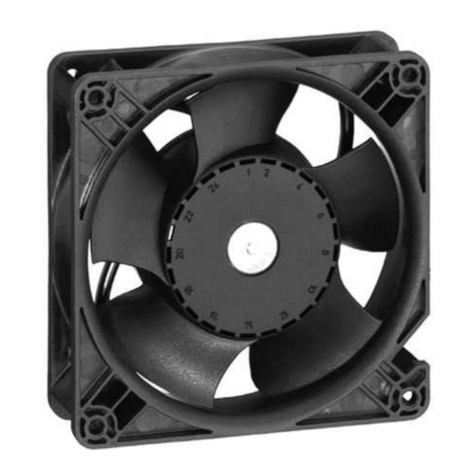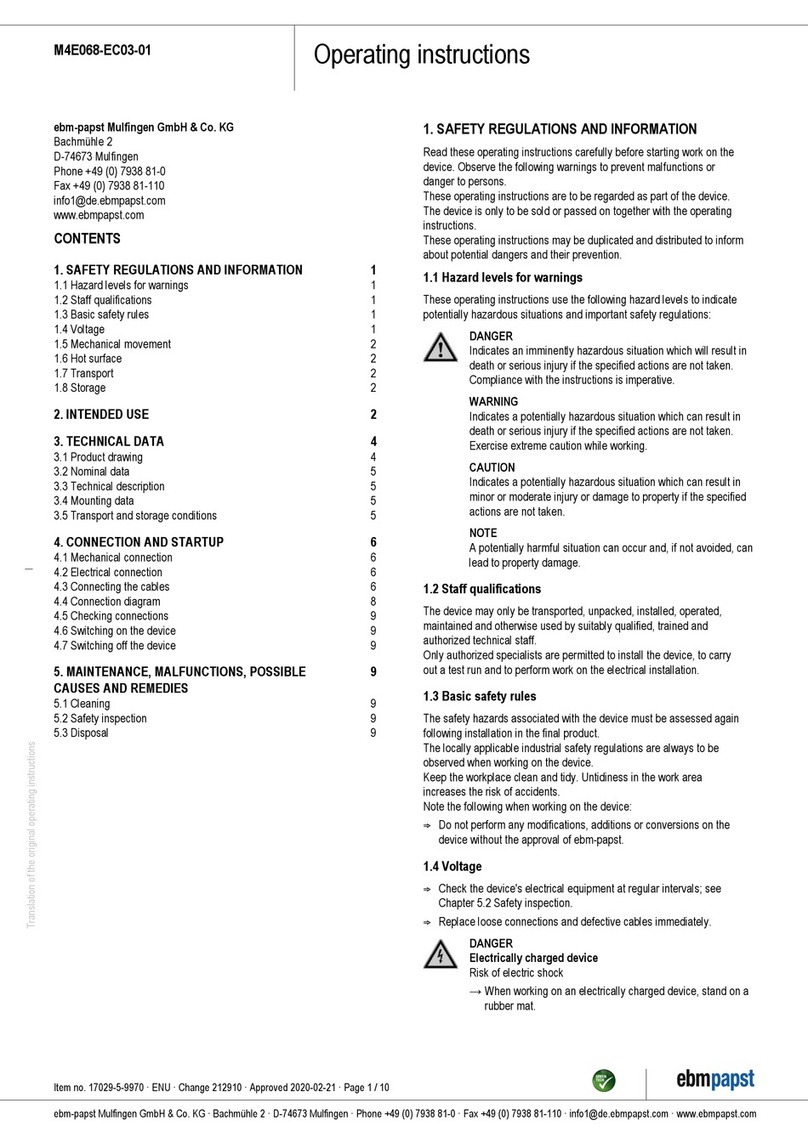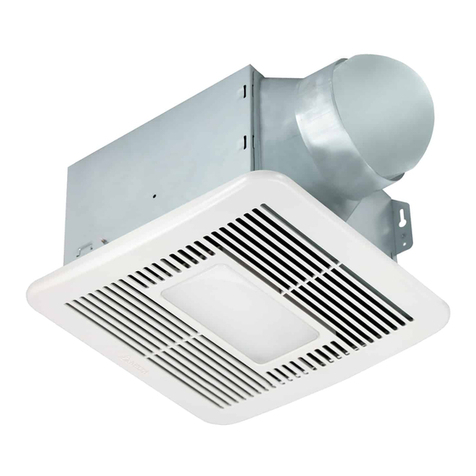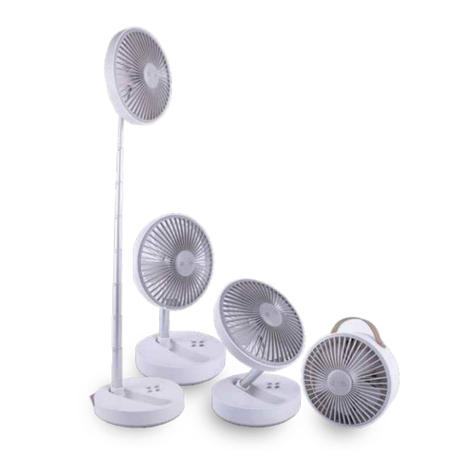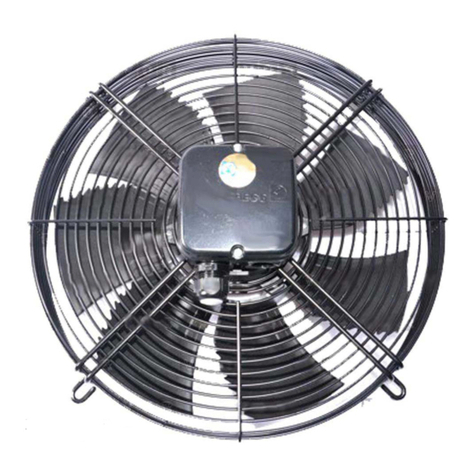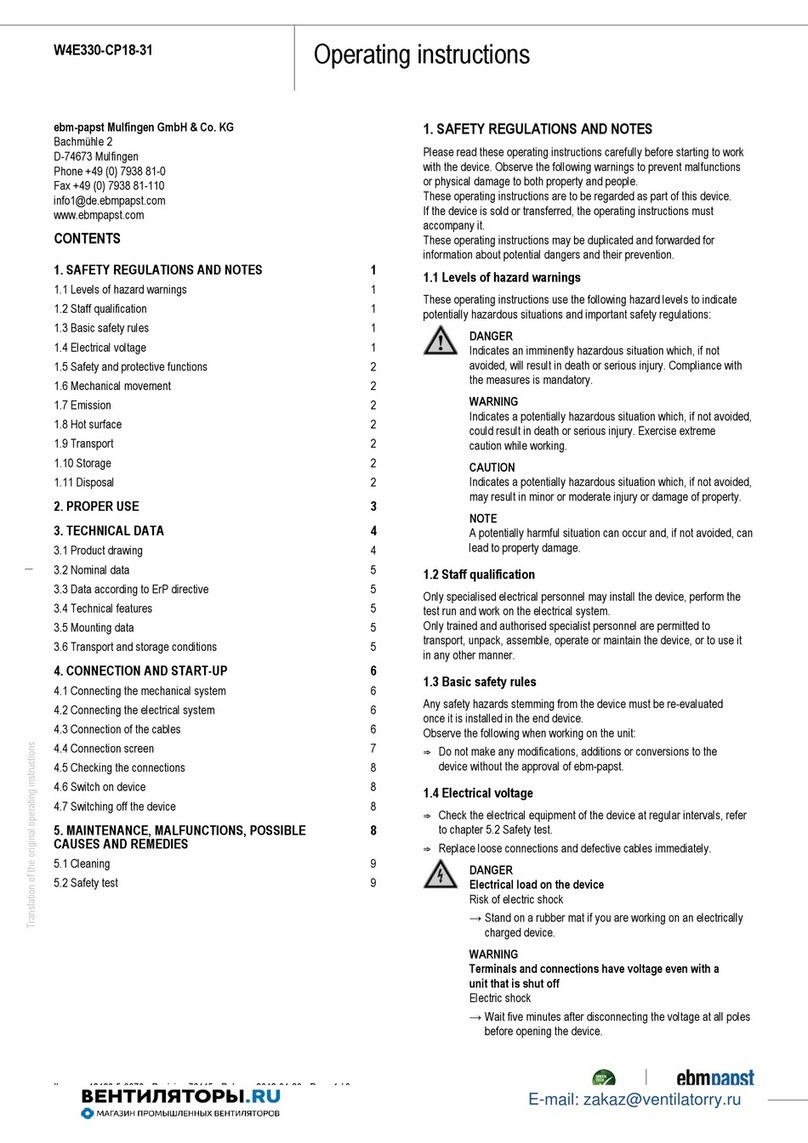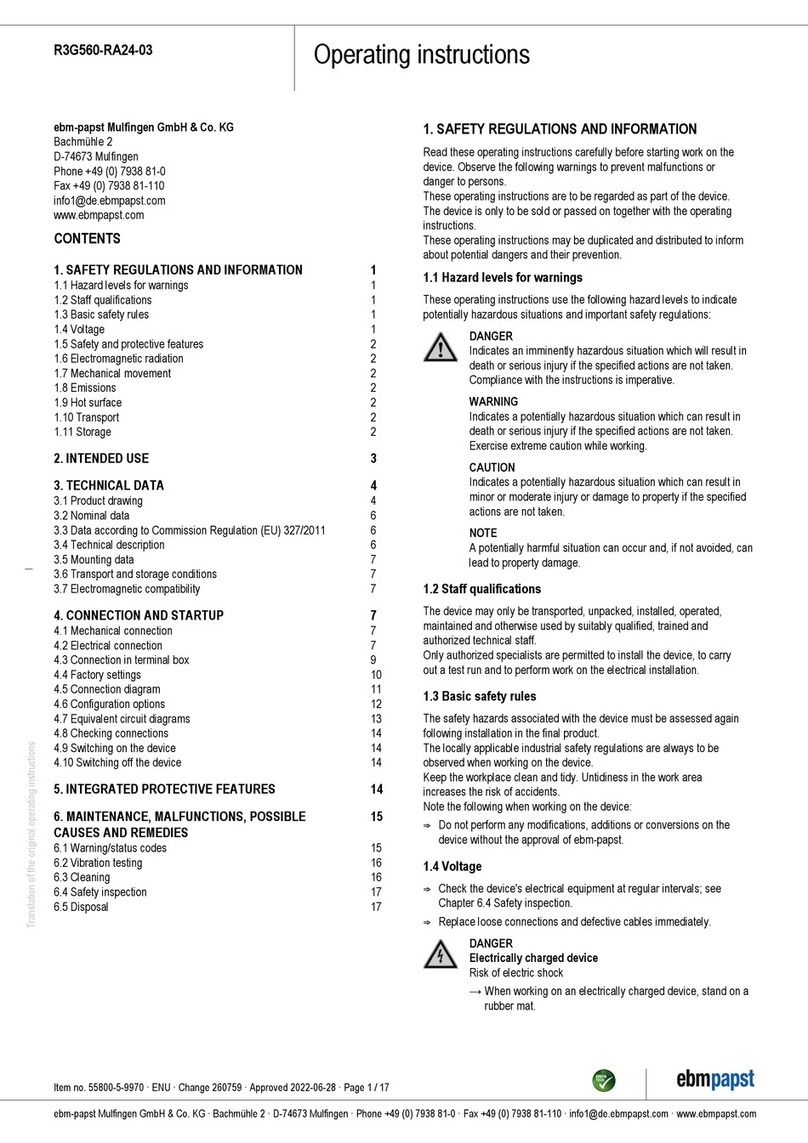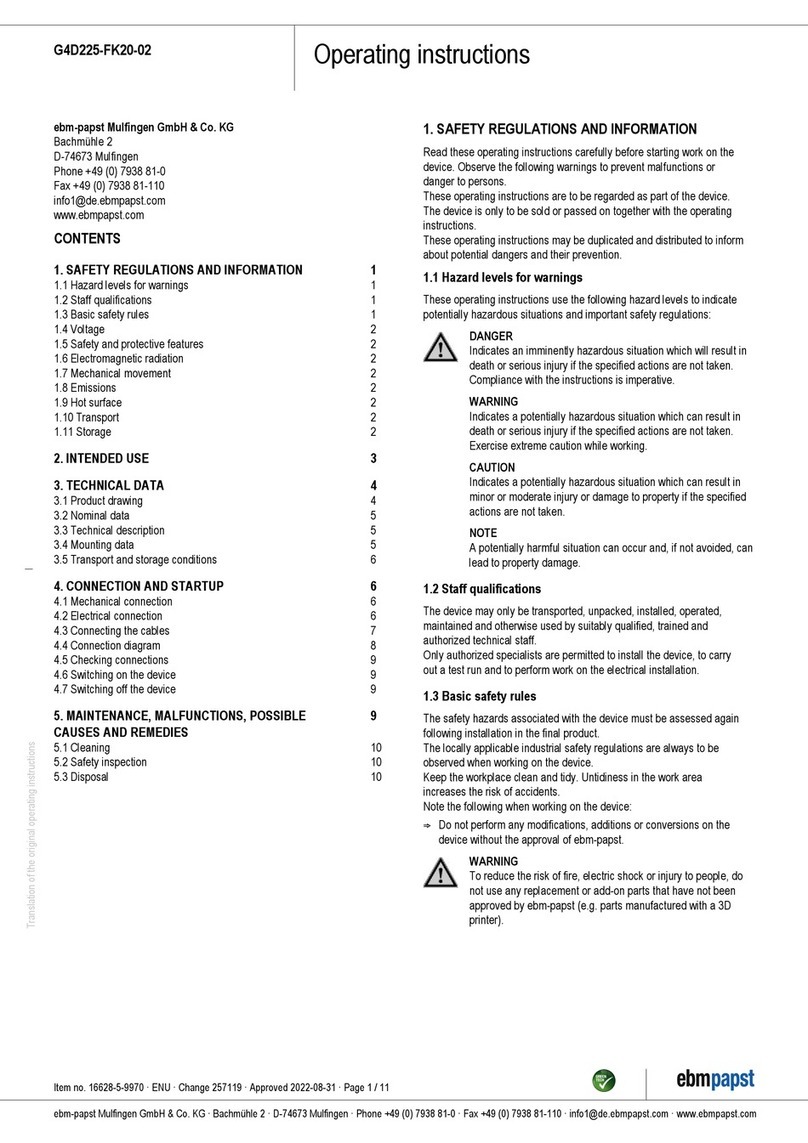Bradford EcoPower 400 User manual

EcoPower®Hybrid Ventilator
Installation Manual
PRINT IN COLOUR

2
1. SYSTEM PRE-REQUISITES –Check Before Commencing
Before attempting to start the installation, please ensure that the following allowable roof pitch and
make-up air requirements can be met.
Product
Make-Up Air* per ventilator - 100%
open, evenly distributed open area
Allowable Roof Pitch
EcoPower 400
≥0.3m²
0°- 45°
EcoPower 600
≥0.5m²
0°- 45°
EcoPower 900
≥0.9m²
0°- 22.5°
* performance values based on 5Pa pressure loss across the make-up air opening.
Additional make-up air can be provided as per the AS1668.2.
DO NOT PROCEED TO INSTALL THIS PRODUCT IF THE ABOVE REQUIREMENTS ARE
UNABLE TO BE MET
2. PACKING LIST –Check Before Commencing
Included Parts
Additional Materials Required - Not Supplied
a. FASTENERS (Quantity and Type)
Product
Head to Varipitch
Varipitch to Flashing
Flashing to Roof
EP400
6
6
12
EP600
9
9
16
EP900
12
12
26
Fasteners
Use 10G X 16MM Galvanised Self Drilling TEK Screws with Neo or
5/32" (4.0mm) Rivets Aluminium/Steel Sealed
b. SUPPLEMENTARY FLASHING (if required) to provide a minimum of 1 dry pan on each side of
the ventilator throat –refer to section 5 for details.
c. SPARKGUARD (if required) for BAL rated applications or to provide protection against the
entry of vermin.
Ventilator Head
Varipitch
Flashing

3
IMPORTANT Note Regarding Lifting This Product
Lift the product in its original packaging using a crane or similar equipment to roof mounting location –prior
to handling the product.
Caution:
The ventilator top surface/dome can be easily scratched or deformed when placed upside down so always
place it on a soft/smooth surface such as cardboard or a soft-foam mat.

4
SAFETY AND WARNINGS
a. Please read this manual carefully before installing this product and keep it for future reference or
provide it to the building owner/maintenance manager.
b. The installation of this product involves working at heights on a sloping surface and may be dangerous
which includes the potential of death, personal injury, or property damage. Please be aware of the
following before installing this product.
c. Follow the state or territory regulator OH&S guidelines for working at height (e.g. Roof work), electrical,
working in elevated temperatures (e.g. roof space in summer). For more information on your state’s
OH&S guidelines for working at heights, please refer to: https://www.safeworkaustralia.gov.au/heights
d. This product must be installed by a qualified installer and all electrical wiring must be undertaken by a
qualified electrician.
e. This hybrid ventilator uses 220V-240V AC power for the electrically powered components and electrical
connections must only be undertaken by a qualified electrician.
f. This hybrid ventilator is supplied with either a Smart Controller or Interface Box - these devices must not
be tampered with and the hybrid ventilator must not be operated without either of these devices.
g. Do not attempt to power up the product when the product is not suitably roof mounted as the turbine
will rotate without warning and may create a hazard.
h. Due to the size and weight of the turbine, it is recommended that it is always lifted by 2 people or a
crane. Refer to the lifting instructions.
i. Damaged parts must be replaced with a genuine replacement part from Bradford Ventilation.

5
3. VENTILATOR POSITIONING & PROVISION FOR MAKE-UP AIR
Bradford Ventilation recommends that ventilators are positioned 4m to 6m away from each other in all
directions for effective and efficient performance. Ensure that the ventilators are not sheltered from the wind
by surrounding objects, the angle created by the roof ridge or from each other.
Make-up air is required for this hybrid ventilator to replenish the exhausted air. As a general guide, the
largest make-up air entry should be positioned on the opposite side of the building to the largest ventilator
demand. The make-up air location should be positioned at optimum height to provide efficient sweeping of
the area.
The illustrations below provide a number of generic ventilator and make-up air layouts but it should be
noted that a whole-of-building assessment, as per AS1668.2, should be conducted by a suitably qualified
person prior to deciding upon site-specific ventilator and make-up air placement.
IMPORTANT: If insufficient external make-up air is provided, the ventilators will draw make-up air from each
other –this will both diminish the effectiveness of the system and increase the risk of the system drawing
external water into the building during periods of rain.
Ventilator
Make-Up Area
Ridge Line
Ridge Line
Ridge Line
Ridge Line

6
4. VENTILATOR INSTALLATION –Ridge Installation
NOTE: Cyclonic application variations to these instructions are set out in Section 6.
a. Set Position: Place the base flashing under the ridge cap in the required position and adjust position to
avoid structural roof members below the roof sheet.
Important Note Regarding Roof Structural Support:
EP400 & EP600 –If the purlin spacing is larger than 600mm, trimmers are required. Install the
trimmers between the purlin on the either side of the opening. Do not cover the openings.
EP900 –If the purlin spacing is larger than 1000mm, trimmers are required. Install the trimmers
between the purlin on the either side of the opening. Do not cover the opening.
b. Mark Hole Position: Ensure the flashing covers the corrugation or ribs equally on each side of
the flashing, then mark a circle on the roof using the hole in the flashing as a template.
c. Cut Hole: Carefully cut the hole, remembering that there may be insulation and other roof
members under the roof sheet. Once the hole has been cut, fold up the edge of the
corrugations or pans.

7
d. Secure Flashing: Attach the flashing to the roof (refer to the table below for the required
number of fasteners). If trimmers are used ensure the flashing is secured to the trimmers. Seal
all fasteners with suitable sealant to ensure they are weatherproof.
e. Assemble the Varipitch: When a Varipitch throat is being used, place the Varipitch on the
flashing and rotate the top and bottom halves until the top of the Varipitch is level (horizontal) -
it is recommended that an electronic or spirit level is used to ensure that the top edge of the
throat is horizontal in all directions.
Secure the Varipitch angle: With the varipitch upper throat positioned horizontally, lock it into
position using the supplied varipitch clip. Use either self-tapping screws or blind rivets to
secure the clip between the two halves of the varipitch.
Model
Fasteners to secure
Flashing to Roof
EP400
12 (4 near throat)
EP600
16 (4 near throat)
EP900
26 (4 near throat)
Use 10G X 16MM Galvanised Self Drilling TEK Screws
with Neo or 5/32" (4.0mm) Rivets Aluminium/Steel
Sealed

8
f. Weather Sealing: Seal the Varipitch seam on the inside with a bead of weather-resistant
suitable sealant.
NOTE: DO NOT apply sealant to the joint between the flashing and Varipitch. This is a natural
gutter to release any trapped condensation.
g. Secure Varipitch to Flashing: Secure the varipitch to the flashing using the recommended
number of screws shown in the table below –DO NOT seal this connection.
Model
Fasteners to secure
Varipitch to Flashing
EP400
6
EP600
9
EP900
12
Use 10G X 16MM Galvanised Self Drilling TEK Screws with
Neo or 5/32" (4.0mm) Rivets Aluminium/Steel Sealed

9
h. Assemble Turbine: Assemble the turbine head to the Varipitch. Re-check if the assembly is
level (horizontal) and adjust the turbine by tilting the throat slightly if required. Ensure the
knurling (the tapered section of the Varipitch) is fully inside the ventilator throat and secure the
ventilator throat by fastening it to the top of the Varipitch with the number of fasteners shown in
the table below.
i. Sealing is crucial for this product to ensure no leaking occur during its lifespan. Ensure the
following areas are sealed;
Go to Section 6 for Additional Requirements for Cyclonic Wind Regions
Model
Fasteners to secure
Turbine to Varipitch
EP400
6
EP600
9
EP900
12
Use 10G X 16MM Galvanised Self Drilling TEK Screws with
Neo or 5/32" (4.0mm) Rivets Aluminium/Steel Sealed
Location Area
Sealing Requirement
All Fasteners
Seal
Flashing perimeter to roof
Seal
Varipitch Seam (inside throat)
Seal
Varipitch to Flashing
Do Not Seal

10
5. VENTILATOR INSTALLATION –Away from Ridge Line - Back-Flashing Required
NOTE: Cyclonic application variations to these instructions are set out in Section 6.
a. Hole Layout: It is recommended that 1 dry pan is flashed on each side of the ventilator throat
cut-out. If the ventilator diameter is greater than 1 pan width and less than 2 pans width –cut a
square hole for 2 pans.
Note :
EP400 & EP600 –If purlin spacing larger than 600mm, trimmers may be required. Install the
trimmers between the purlin on the either side of the opening. Do not cover the openings.
EP900 –If purlin spacing larger than 1000mm, trimmers may be required. Install the trimmers
between the purlin on the either side of the opening. Do not cover the opening.
2 Pans width for
Ventilator Throat
Fold up on
both ends
Throat
Provide 1 dry pan each
side of the metal roof
cut-out

11
b. Back-Flashing Assembly: Ensure that the width of the back-flashing tray is sufficient to cover at
least 1 dry pan on each side of the cut-out in the metal roof. Position the flashing in the middle
of the tray with 1 dry pan on each side of the flashing cut-out. Mark a circle using the hole in
the flashing as a template and cut the hole in the back-flashing tray.
Secure the ventilator’s flashing to the back-flashing tray using the recommended number of
fasteners shown in the table below:
Note: Always provide 1 dry pan on each side of the ventilator throat to avoid water or rain
ingress.
Model
Fasteners to secure
Flashing to Roof
EP400
12 (4 near throat)
EP600
16 (4 near throat)
EP900
26 (4 near throat)
Use 10G X 16MM Galvanised Self Drilling TEK Screws
with Neo or 5/32" (4.0mm) Rivets Aluminium/Steel
Sealed
Provide 1 dry pan each
side of the metal roof
cut-out

12
c. Assemble Back-Flashing: Secure the back-flashing tray to the roof using a minimum of one
10G X 16MM Galvanised Self Drilling TEK Screws with Neo or 5/32" (4.0mm) Rivets
Aluminium/Steel Sealed every 150mm.If trimmers are used ensure the flashing is secured to
the trimmers. Seal all fasteners with suitable sealant to ensure they are weatherproof.
d. Assemble the Varipitch: When a Varipitch throat is being used, place the Varipitch on the
flashing and rotate the top and bottom halves until the top of the Varipitch is level (horizontal) -
it is recommended that an electronic or spirit level is used to ensure that the top edge of the
throat is horizontal in all directions.
e. Secure the Varipitch angle: With the varipitch upper throat positioned horizontally, lock it into
position using the supplied varipitch clip. Use either self-tapping screws or blind rivets to
secure the clip between the two halves of the varipitch.

13
f. Weather Sealing: Seal the Varipitch seam on the inside with a bead of weather-resistant
suitable sealant.
NOTE: DO NOT apply sealant to the joint between the flashing and Varipitch. This is a natural
gutter to release any trapped condensation.
j. Secure Varipitch to Flashing: Secure the varipitch to the flashing using the recommended
number of screws shown in the table below –DO NOT seal this connection.
Model
Fasteners to secure
Varipitch to Flashing
EP400
6
EP600
9
EP900
12
Use 10G X 16MM Galvanised Self Drilling TEK Screws with
Neo or 5/32" (4.0mm) Rivets Aluminium/Steel Sealed

14
g. Assemble Turbine: Assemble the turbine head to the Varipitch. Re-check if the assembly is
level (horizontal) and adjust the turbine by tilting the throat slightly if required. Ensure the
knurling (the tapered section of the Varipitch) is fully inside the ventilator throat and secure the
ventilator throat by fastening it to the top of the Varipitch with the recommended number of
fasteners shown in the table below.
h. Sealing is crucial for this product to ensure no leaking occur during its lifespan. Ensure the
following areas are sealed ;
Go to Section 6 for Additional Requirements for Cyclonic Wind Regions
Model
Fasteners to secure
Turbine to Varipitch
EP400
6
EP600
9
EP900
12
Use 10G X 16MM Galvanised Self Drilling TEK Screws with
Neo or 5/32" (4.0mm) Rivets Aluminium/Steel Sealed
Location Area
Sealing Requirement
Fasteners
Seal
Flashing
Seal
Varipitch Seam
Seal
Varipitch to Flashing
Do Not Seal
End of the ribs
Seal
Tray
Sealed and fixed to the roofing
Tray Notches
Folded down into pans –do not seal
Varipitch to Flashing –DO NOT SEAL
Fold down the tray notches –DO NOT
SEAL

15
6. CYCLONE REGION INSTALLATION –Additional Requirements for Cyclonic Wind Regions
The specific installation instruction variations in this section must be applied to installations in
cyclonic regions or where the use of a cyclonic restraint has been designated –replace guidance
in Section 6 & 7 with specific information in this Section.
Fastener Selection
a. Fix Flashing to roof with 14G Class 3 or 4 Tek screws. Locate 4 close to Varipitch and 26
around the 4 sides of the flashing.
b. Fix Varipitch to Flashing with 12 x 6-4 AS blind rivets. Seal with suitable sealant if unsealed
rivets are used.
c. Fix Throat to Varipitch with 12 x 6-4 AS blind rivets. Seal with suitable sealant if unsealed rivets
are used.

16
Cyclone Strap Assembly
Note: Safety mesh shall not be removed. The safety mesh has been removed in the above
figure to show internal installation of the cyclone strap only.
d. Attach the 30x0.8x950mm long Cyclone Straps to the inside top edge of the Varipitch, down to
the underside of a roof purlin as shown above.
e. Fix both cyclone fixing straps to the inside of the varipitch with at least 4 x 6-4 AS rivets. Two
rivets must be located above the varipitch seam with one through the throat, varipitch and
strap.
f. Fix the lower end of the strap to the purlin with M8 hex head screws (minimum class 4.6) and
two M8 nuts per screw.

17
Cyclone Strap Assembly - Cross Section View 1
Cyclone Strap
4 x 6-4 AS Rivets
Purlin
2 x M8 Nuts
M8 x 25 Hex Head
Screw

18
Cyclone Strap Assembly - Cross Section View 2
Cyclone
Strap
Varipitch
Ventilator
Throat

19
7. MAINTENANCE
Regular maintenance of this product is essential to ensure its safe and long-term operation. It is the
responsibility of the building owner or manager to outline the maintenance program throughout the
products lifespan. The following components should be inspected on a regular basis:
WARNING: Prior to inspecting the ventilator ensure that the power is turned off and that the ventilator head
is held in a static position by another person using a gloved hand on the top surface of the turbine (away
from the turbine blades) –this should not be undertaken on a windy day when the turbine head cannot be
safely slowed
•Rotating/turbine head –check for excessive movement/contact between components, unusual noise
during rotation, listen for noises and assess visual wear & tear.
•Fasteners –check all are in situ and well sealed.
•Flashing Connections –check joints that are meant to be sealed remain sealed and that those that
are meant to be unsealed are clear of obstruction.
•Sparkguard (if provided) –ensure this is clear of debris.
•Cyclone Strap (if provided) –check fastener tension.
•Electrical component and connections –check connections for wear or exposure damage.
8. TROUBLESHOOTING GUIDE
No
Failure Mode / Potential Cause(s)
Image / Description
1
Water or rain leakage.
Varipitch connection not sealed.
The photo in the sidebar shows the possible outcome if
the varipitch connection has been slightly separated
during angle adjustment or has not been sealed with
silicon.
ACTION: Seal varipitch connection.
2
Water or rain leakage.
Ventilator throat gutter blocked.
Placing silicon around the bottom of the vent throat
where it contacts the flashing blocks the vent gutter at
the base of the throat, preventing the release of internal
condensation and mist from the inside of the throat.
ACTION: Remove blockage

20
3
Water or rain leakage.
Insufficient turndowns along the front edge of the back-
flashing due to low roof pitch and driving rain.
ACTION: Extend and seal flashing.
4
Water or rain leakage.
No back-flashing provided.
ACTION: Extend back-flashing to under sheet above or
roof ridge.
5
Water or rain leakage.
Ventilator throat shortened or not used which allows rain
‘bounce’ to drive water off roof into ventilator.
ACTION: Install recommended ventilator throat.
6
CAUTION: Reliance upon flexible sealants.
Through expansion and contraction of building components over time, silicon may develop cavities
or cracks which then permit water ingress. It is always recommended that mechanically overlapped
seals are created with metal components to provide water protection and that flexible sealants are
used to provide secondary protection. While it is recommended that silicon be applied over roofing
screws - it is more reliable to use high quality blind rivets or roofing screws with integrated washers.
7
Failure to Use Ventilator Throat.
It is crucial that the ventilators are installed with a varipitch to ensure the turbine has adequate
clearance from the flashing. Failure to comply with this recommendation could lead to rain ingress
through the vanes resulting in leakage.
8
Creation of Negative Pressure in a Building Leading to Back-drafting.
The demand for make-up air by the ventilators leads to the creation of sufficient negative pressure in
the building that vents of a lower height (downslope from ridge) can be forced to rotate in the
opposite direction to, in effect, supply air to equalise pressure. This can lead to rain being
inadvertently draw into the building when the phenomenon occurs during wet weather.
The characteristics of this phenomenon occur when:
a. The building is very air-tight and make-up air is not balanced.
This manual suits for next models
5
Table of contents
Other Bradford Fan manuals
Popular Fan manuals by other brands
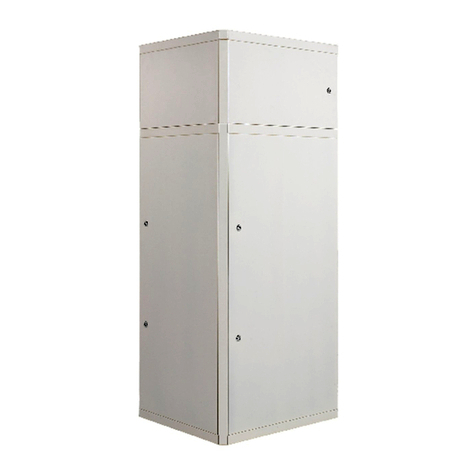
System air
System air Combi Unit Genius Installation, operation and maintenance instructions
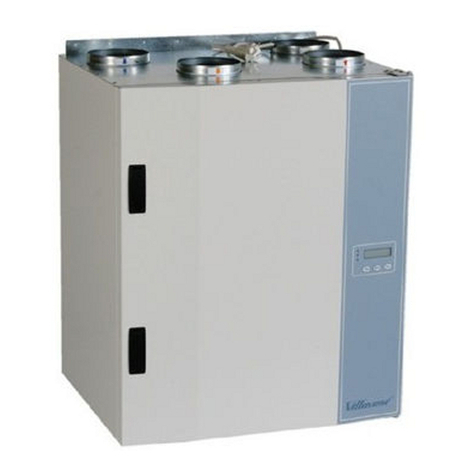
System air
System air VM User and maintenance instructions

Ebmpapst
Ebmpapst G3G133-RF15-03 operating instructions
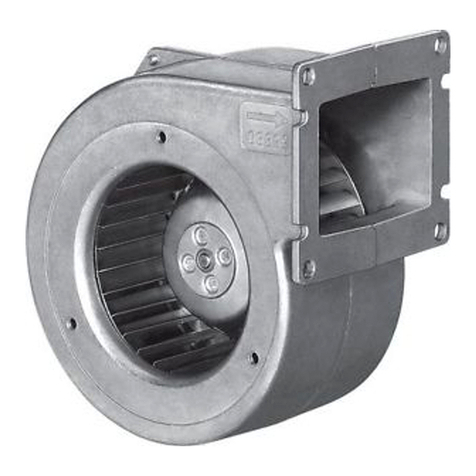
Ebmpapst
Ebmpapst G1G085-AB05-01 operating instructions
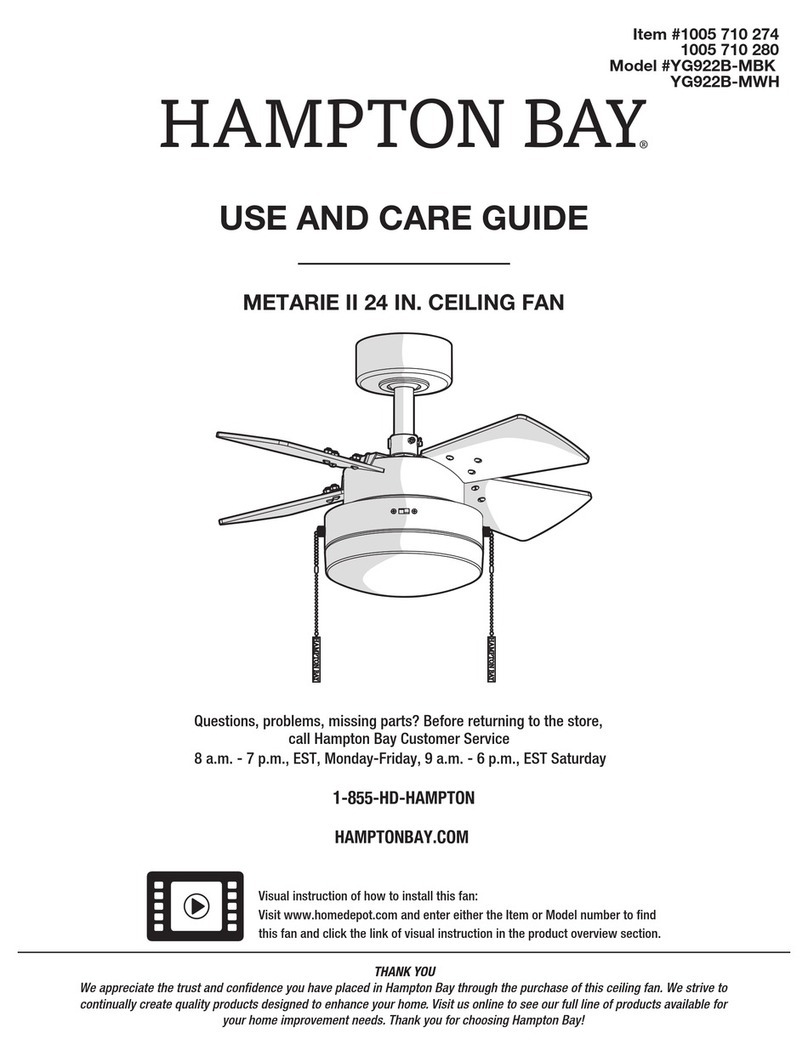
HAMPTON BAY
HAMPTON BAY METARIE II YG922B-MBK Use and care guide

Ebmpapst
Ebmpapst A4E450-AN05-01 operating instructions



